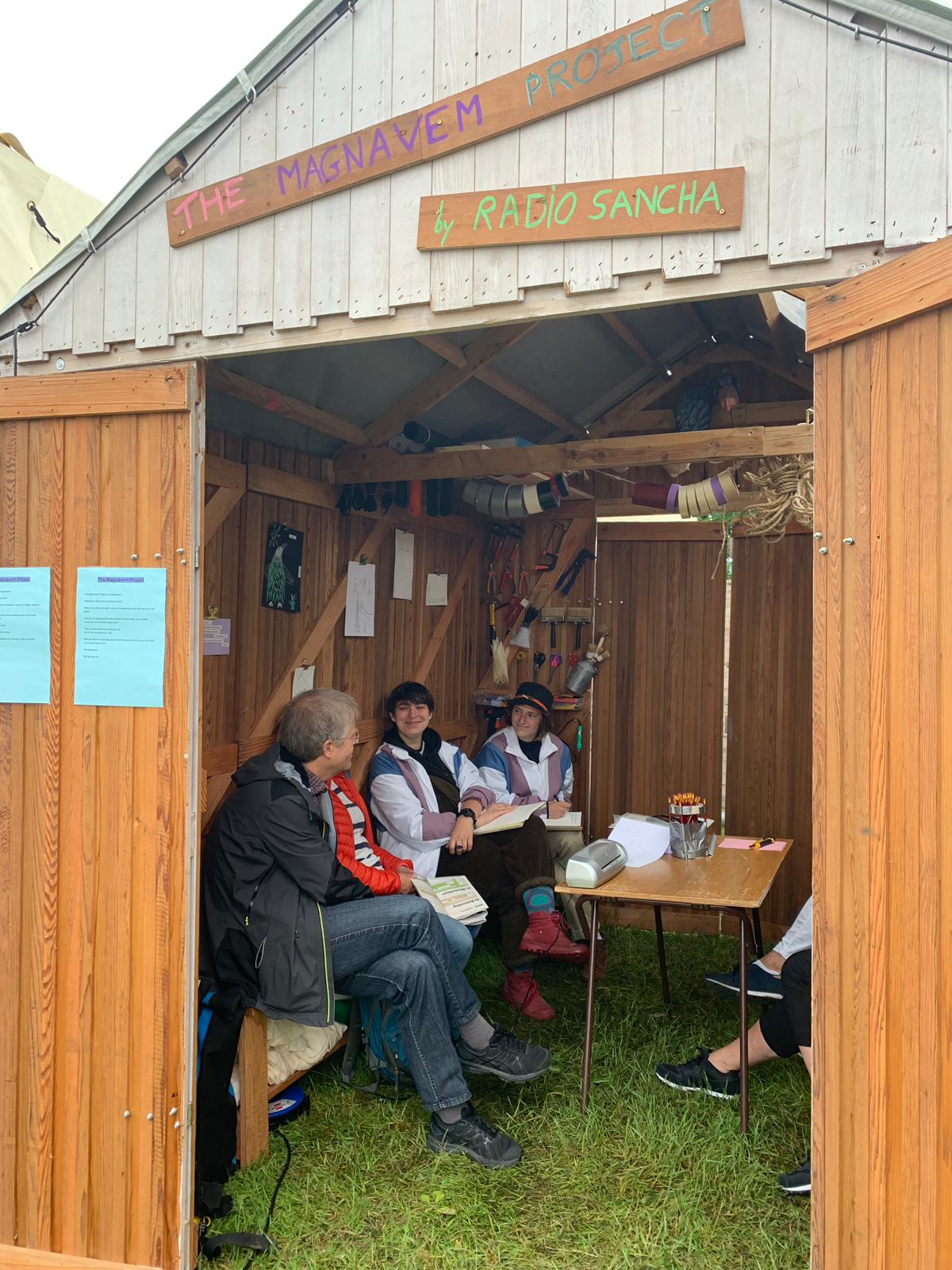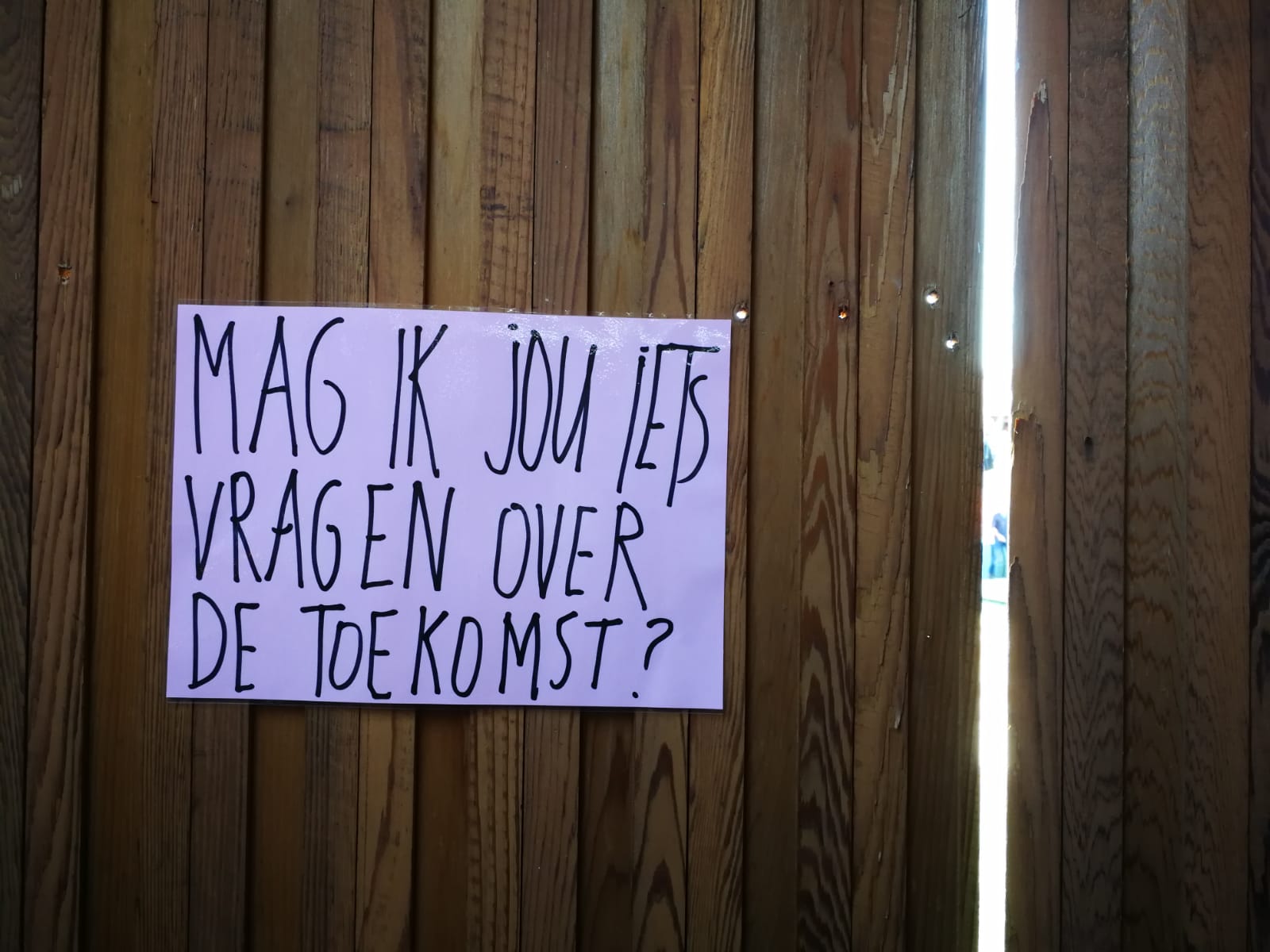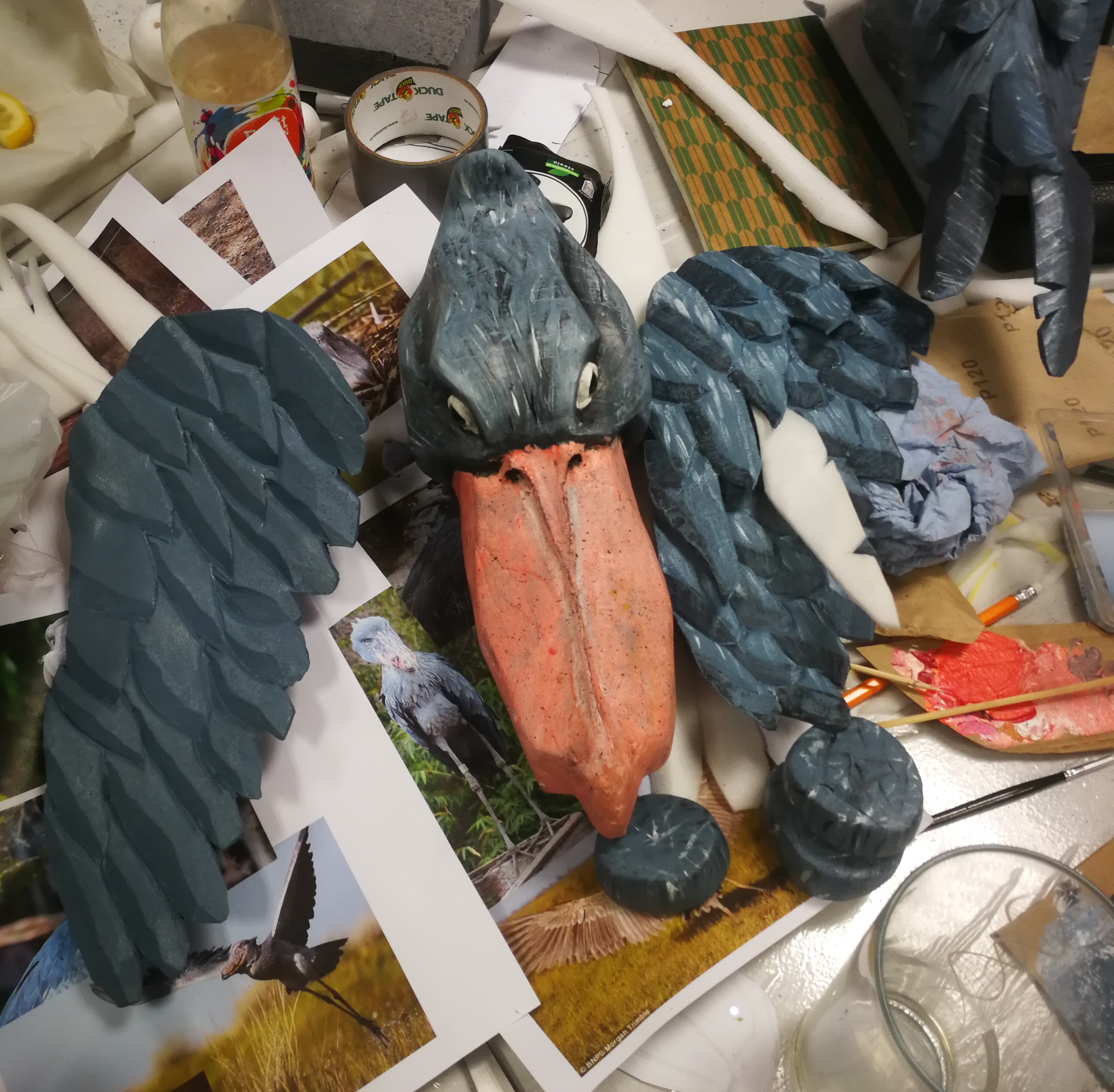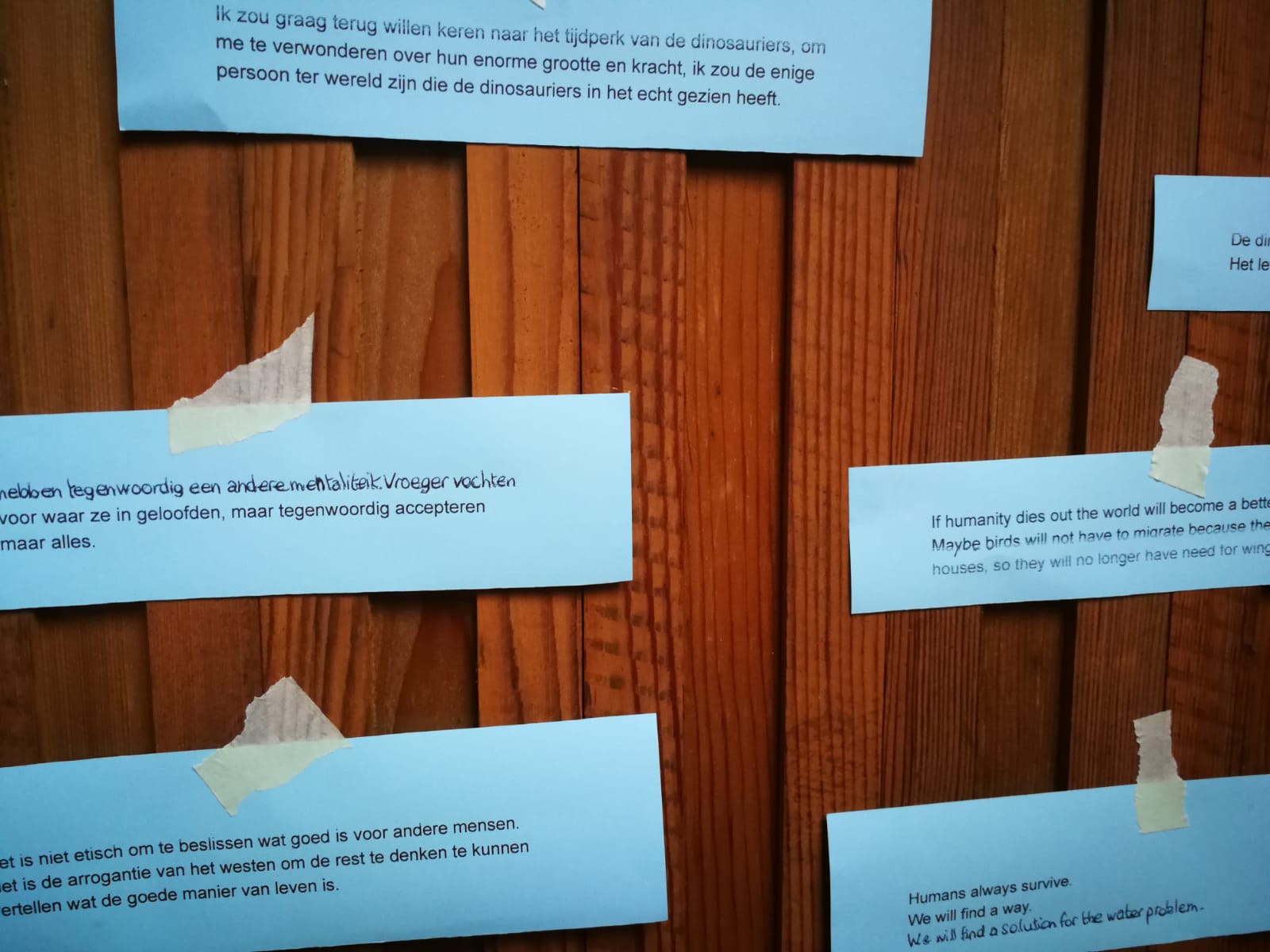The Magnavem Project at Oerol 2019 is a participatory and accelerated version of the creation process for Over de geur van vers brood en de schaal van de dingen.
The Magnavem is a giant bird from the far away future resulting from our collective imagination. It will later become a performance involving puppetry, circus, speculative biology, theatre and philosophy. The show is created and performed by Camille Paycha and Noortje Sanders.
But here at Oerol, we are in 10 days, with the help of people, going through all the steps of the creation of our giant bird: the Magnavem, in all its aspects. We will do this through workshops, open discussions, performative elements and collaborative research with the audience.
Below you will find a daily journal to follow the progress of the project.
The project has one set location at WESTERKEYN, we will refer to this location as “nest”.
The Magnavem Project
/Oerol 2019
DAILY JOURNAL
News, archive...
11/06/19
Our nest is almost done at Westerkeyn.
Thanks to the technician!
14/06/19
Day 1 at Oerol Terschelling is over. Today we invited people in our little house to discuss about the future and the place of humans in this future. We talked about overpopulation, DNA modifications (on humans and on animals), if humanity will disappear, if yes when about. 50 years from now? 200? 1000? 8000 years from now? Will animals be better off without humans? How will nature then evolve? Will there be nature? Or else a big bloodymass? Something such as the apocalypse maybe... Was it better before? Will our "intelligence" save us? Or kill us? Is nature stronger than us? ...
Here are a few quotes from our visitors:
"We need something dramatic to be able to change".
"If humanity dies out: it will become a better place for animals. Maybe birds will not have to migrate because they will live in the empty houses so they will no longer have need for wings".
"It would be good to make the perfect human but what would it look like? We shouldn't all be clones".
"I am too scared to go too far in the future".
"The dinos are going to come back and then the apes, life is a circle".
"If humanity has died out: the lion will be the dominant one a bit the same but with different colors".
"We should go back to nomadic times, but I don't think its possible".
"People these days have a different mentality. In my days people would fight but now people just accept everything".
... and wayyyy more.
Tomorrow we will speculate together on the basis of scenarios coming from today's discussions.
Everyday something different happens in our little house. We are looking forward to tomorrow!



15/06/19

Today we went on with the conversations after a rainy morning.
Whereas the conversations of yesterday were about the "big picture" (humanity, technology, evolution...), the goal of today's conversations was to elaborate scenarios in which the bird could take place. In order to do so we used some quotes from yesterday's visitors.
Does this bird live in a warm place? Ice Age? Is there oxygen? Is it on our planet? Or another one? On Mars? Does it have to travel? Why? Is there food for the bird? Is there water? ...
Little ones and grown-ups could then imagine those scenarios. Some scenarios were based on scientific knowledge, some from a wild imagination. But all of them could compete with the best science-fiction stories we know.
Here are four scenarios from today's visitors:
De thermiek vogel
De wereld is warmer en warmer geworden. Bijna alle diersoorten zijn uitgestorven. De thermiek vogel leeft op de dorre vlaktes. Er zijn bijna geen planten meer over maar de planten die over zijn zitten vol water. Dus door die te eten krijgt de thermiek vogel genoeg vocht binnen. Iedere ochtend stijgt de thermiek vogel op door de warme lucht die omhoog gaat, en blijft stijgen de rest van de dag. Als de nacht valt en het koeler wordt begint de thermiek vogel langzaam te dalen, om een paar uur later weer om de grond terecht te komen. Naast de planten eet de thermiek vogel ook vissen. Maar aangezien de meeste vissen zijn uitgestorven en de laatste vissen die er zijn helemaal op de zeebodem zwemmen om te ontsnappen aan de hitte moet hij daar heel diep voor duiken. Dit doet hij dan ook alleen als hij door de koele lucht van de avond toch al naar de zee gedaald is. Daarna dobbert hij de rest van de nacht op de zee, tot hij in de ochtend weer op kan stijgen.
De archeologie vogel
De wereld kwam terecht in een grote ijstijd dus de mensheid is vertrokken naar mars en het grootste deel van de diersoorten zijn uitgestorven. Na de ijstijd is het ijs gaan smelten en toen kwam de archeologie vogel op. Het is een vogel die niet meer kan vliegen, omdat hij toch geen land vijanden meer heeft. De archeologie vogel graaft een kuil, hij begint hier mee als hij jong is en graaft zijn hele leven aan dezelfde kuil. Deze kuil gebruikt hij voor verkoeling. De planeet is immers snel aan het opwarmen. Daarnaast graaft hij in deze kuil de fossielen van vroegere diersoorten op. Uit deze fossielen haalt hij alle voedingsstoffen die hij nodig heeft om te overleven. Naarmate hij dieper graaft komt hij langs verschillende tijdsperiodes, en aangezien de fossielen uit die verschillende tijden verschillend opgebouwd zijn veranderd zijn eigen uiterlijk ook. Hij verandert dan net een beetje van kleur of wordt iets groter of kleiner.
De overgans
De overgans komt van een andere planeet, eentje die bijna helemaal uit water bestaat. Er leven twintig overganzen op onze planeet, nooit meer en nooit minder. de overgans eet plastic en is naar onze planeet gekomen omdat wij zo veel plastic hebben. De overgans wordt gedurende zijn leven steeds groter, maar als hij terug naar zijn eigen planeet wilt moet hij in de ruimte stukjes van zichzelf opofferen en wordt hij dus weer kleiner. Vijf van de twintig overganzen kunnen door de ruimte reizen en de rest heeft hoogtevrees. De overgans kan het water van de aarde niet drinken en heeft dus een hele lange tong, waarmee hij helemaal kan reiken naar zijn eigen planeet om daar water te drinken. Terwijl hij dat water aan het drinken is fungeert zijn tong als een soort brug tussen de twee planeten, vandaar de naam overgans. Over deze brugtong reizen kleine diertjes van de waterplaneet naar onze planeet. Deze diertjes leven vervolgens in de bek van de overgans, waar ze het plastic sorteren wat de overgans eet. Dit plastic poept de overgans vervolgens uit uit tien verschillende poepgaten. Een specifiek poepgat voor iedere soort plastic. Hij doet dit boven een vulkaan, zodat het plastic daar gesmolten wordt en hergebruikt kan worden.
De fotosynthese vogel
De wereld is oud en er is nog maar weinig zuurstof over. De fotosynthese vogel is heel klein zodat hij niet zo veel zuurstof nodig heeft. In de holle schachten van de veren van zijn vleugels is een fotosynthetisch proces gaande. Met iedere neergaande beweging van zijn vleugels stroomt er co2 naar de veerschachten. Door de bolle vorm van deze schacht wordt het licht van de zon er extra goed in opgevangen. Dit zonlicht zet de co2 dan om in glucose, wat met de opgaande beweging van de vleugel terug stroomt naar de rest van het lichaam. hierdoor kan de vogel eindeloos blijven vliegen en heeft het bijna geen andere voedingsstoffen nodig. De fotosynthese vogel heeft een hard schild op zijn borst. Hij vliegt regelmatig flinke stukken omhoog en daarna weer naar beneden. Door deze snelle hoogte- en daarmee ook temperatuurverschillen condenseert er water uit de lucht op zijn harde schild. Dit water likt hij op met zijn lange tong en voorziet hiermee in zijn eigen vochttoevoer.
Third day on the island and the birds are coming to life.
Today we invited people to imagine the new bird species with us in a more detailed way. Depending on scenarios about how the world will look like in the future, the visitors invented their own bird in all its aspects. They had to think of the bird's habitat, what this bird eats, how it breeds, whether it is dependant on seasons, if it lives in groups ... Our dear inventors/researchers came up with brilliant birds from the future through texts or/and drawings.
You can find a few examples here.
We continue this process tomorrow to feed the collective archive.
18/06/19
16/06/19
One more day of collecting information with the visitors. Our database of birds from the future is getting bigger. The conversations also went on about how the future will look like. There is one obvious thing: everyone has an opinion. Because there is no way of holding the truth, imagination and fantasy are taking over. It is precisely this process that we find the most interesting: to let the imagination grow from observations of the world of today. Because that is the only thing we can do: observe and imagine.
17/06/19
First building day! We start the first building day with an overview of all the birds created the past few days at the back of our mind. We are going to use some parts of a few birds and put them together in one giant movable bird. We use for that willow branches and paper tape as material. Today we managed to build the body of the bird. Ah and also... we were in the Oerol dagkrant today :D
19/06/19
Second day out of four to build the bird. Today our focus was on the wing system. The system works well and the willow branches give a nice delay to the wings movement. We think that the wings should be bigger. That is on our to do list of tomorrow.
20/06/19
Today the focus goes on the head. It took us a bit of time to figure which shape the head should take. The beak is also an important aspect of the head.
21/06/19
Last building day! Only four days to build a giant movable bird is not a lot but I think we can call it an accomplished mission.
We finished the head in all its details (eyes, long plastic tong, opening system of the beak). We attached the head to the body and made the articulation wings of the long neck of the magnavem. We made a strong support at the core of the bird in order for people to manipulate it. We also added some parts to the tail to make it well-rounded.
22/06/19
The goal of this morning is to bring the bird to life. In order to do so we invited professional puppet player Ruben Mardulier. Ruben gave a workshop in puppet manipulation to a group a 15 enthusiastic people. In one and a half hour he taught us about the extreme listening that puppet players need to have between each other. We went from listening exercises on the floor to specific manipulation exercises with the head of the bird. At the end of the workshop every participant could, in groups of three, manipulate the magnavem and let it fly on the festival terrain of Westerkeyn. The magnavem, bird of the future, is definitely alive today.
23/06/19
The magnavem is alive. It flies in the streets, on the beach and funny enough likes to interact with people.